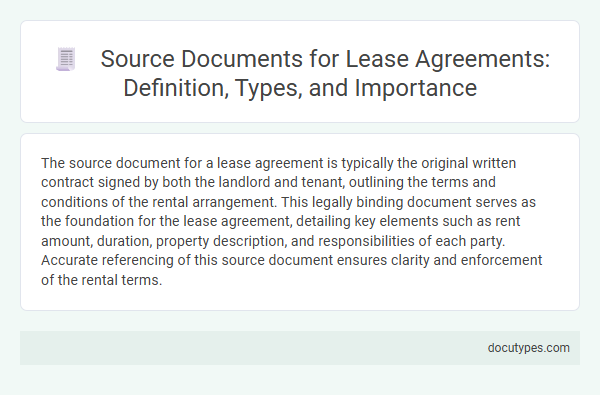The source document for a lease agreement is typically the original written contract signed by both the landlord and tenant, outlining the terms and conditions of the rental arrangement. This legally binding document serves as the foundation for the lease agreement, detailing key elements such as rent amount, duration, property description, and responsibilities of each party. Accurate referencing of this source document ensures clarity and enforcement of the rental terms.
Introduction to Source Documents in Lease Agreements
The source document in a lease agreement outlines the foundational terms and conditions between the landlord and tenant. Understanding this source document is essential for ensuring clear property rental arrangements and legal compliance.
- Lease Agreement Form - The primary document that details the rental terms, responsibilities, and duration agreed upon by both parties.
- Property Title or Ownership Proof - Confirms the landlord's legal right to lease the property in question.
- Previous Lease or Rental History - Provides context or precedent for terms and clauses included in the current lease agreement.
What Are Source Documents?
Source documents are the original records that provide the foundational information for creating a lease agreement. These documents include prior contracts, property deeds, and identification papers relevant to the lease.
They serve as the primary evidence of the terms and conditions agreed upon by the parties involved. Accurate source documents ensure the lease agreement is legally binding and enforceable.
Key Types of Source Documents for Lease Agreements
A source document for a lease agreement serves as the original record that outlines the terms and conditions agreed upon by the landlord and tenant. Identifying key types of source documents is essential for validating and enforcing lease agreements.
- Lease Proposal - This initial offer from the landlord outlines the basic terms and conditions intended for the lease agreement.
- Letter of Intent - A preliminary document that expresses the intentions of both parties before finalizing the actual lease agreement.
- Draft Lease Agreement - A detailed version of the lease outlining specific obligations, rights, and responsibilities of involved parties before signing.
Each of these source documents plays a critical role in establishing a legally binding and clearly defined lease agreement.
Importance of Source Documents in Leasing Processes
The source document for a lease agreement is the original lease contract signed by both parties outlining the terms and conditions of the rental arrangement. This document serves as the primary legal reference for rights, responsibilities, and obligations throughout the lease term.
Source documents are crucial in leasing processes because they provide verifiable proof of the agreed terms and support dispute resolution if conflicts arise. Your accurate maintenance of these documents ensures transparency and legal protection in all leasing transactions.
Common Examples of Lease Source Documents
What is the source document for a lease agreement? The source document serves as the original paperwork or record from which the lease agreement is derived. Common examples of lease source documents include property appraisal reports, previous lease contracts, and property ownership certificates.
Legal Relevance of Source Documents in Lease Agreements
The source document for a lease agreement is the original contract that outlines the terms agreed upon by the landlord and tenant. Legal relevance of source documents in lease agreements ensures the enforceability of rights and obligations detailed within the contract. You must retain this document as it serves as proof in disputes and guides lease enforcement under applicable property laws.
How to Verify Authenticity of Source Documents
| Aspect | Details |
|---|---|
| Source Document for a Lease Agreement | The original lease agreement signed by both landlord and tenant serves as the primary source document. This document outlines terms, conditions, rental amounts, and obligations for all parties involved. |
| Characteristics of the Source Document | Includes signatures, dates, property details, payment schedules, and legal clauses. It may also have attachments like property inspection reports or identification documents. |
| How to Verify Authenticity |
|
| Importance of Authentic Verification | Ensures enforceability of lease terms, protects parties from fraud, and provides a reliable legal record in case of disputes or litigation. |
Best Practices for Document Management in Leasing
The source document for a lease agreement is the initial signed lease contract between the landlord and tenant detailing all terms and conditions. Proper document management ensures the integrity and accessibility of this essential record throughout the lease term.
- Centralized Storage - Maintain all lease agreements in a secure, centralized digital repository for easy retrieval and compliance.
- Version Control - Implement strict version control to track amendments and avoid confusion over the current agreement terms.
- Regular Audits - Conduct periodic audits of lease documents to ensure accuracy, completeness, and adherence to legal requirements.
Consequences of Missing or Inaccurate Source Documents
The source document for a lease agreement typically includes the original lease contract, property deeds, and any prior agreements related to the property. Missing or inaccurate source documents can lead to disputes over terms, legal challenges, and difficulties in enforcing the lease. Ensuring your lease agreement is backed by precise source documents protects your rights and supports clear, enforceable rental arrangements.
What Is the Source Document for a Lease Agreement? Infographic

